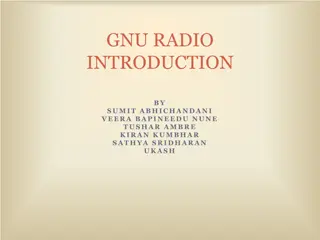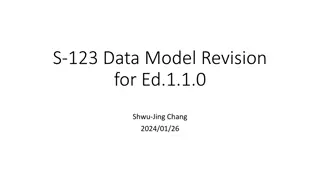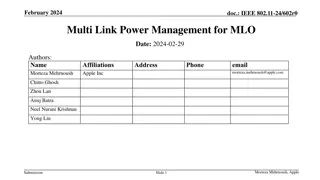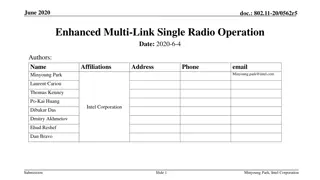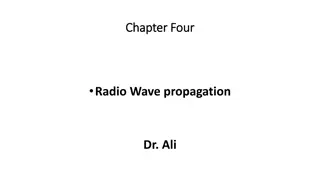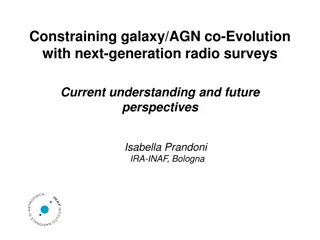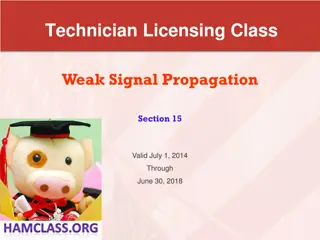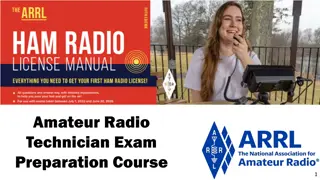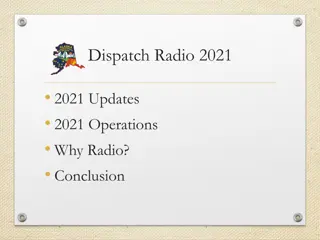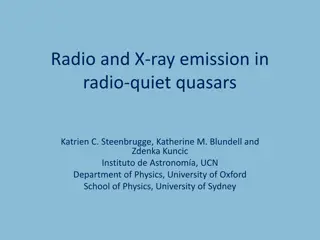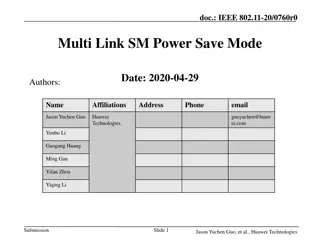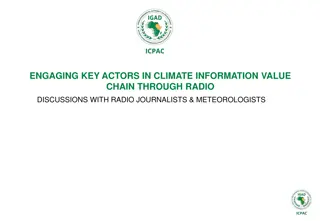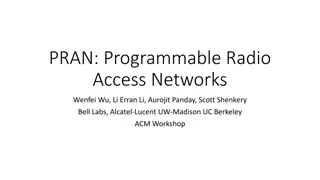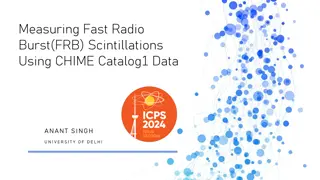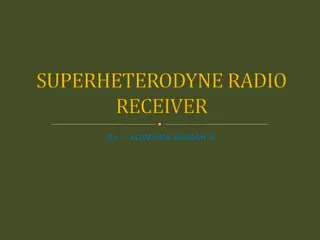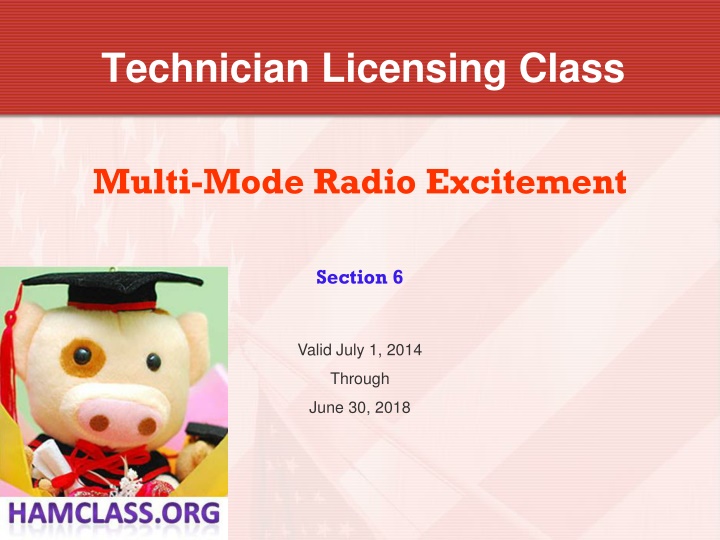
Multi-Mode Radio Excitement in Technician Licensing Class
Explore the world of multi-mode radio excitement in the Technician Licensing Class, covering topics like transceivers, modulation, single sideband, and more. Learn about the functionalities and advantages of different modes for effective communication in the radio field.
Download Presentation

Please find below an Image/Link to download the presentation.
The content on the website is provided AS IS for your information and personal use only. It may not be sold, licensed, or shared on other websites without obtaining consent from the author. If you encounter any issues during the download, it is possible that the publisher has removed the file from their server.
You are allowed to download the files provided on this website for personal or commercial use, subject to the condition that they are used lawfully. All files are the property of their respective owners.
The content on the website is provided AS IS for your information and personal use only. It may not be sold, licensed, or shared on other websites without obtaining consent from the author.
E N D
Presentation Transcript
Technician Licensing Class Multi-Mode Radio Excitement Section 6 Valid July 1, 2014 Through June 30, 2018
Multi-Mode Radio Excitement T7A02A transceiver combines both transmitting and receiving functions in one package T7A09 A multi-mode VHF transceiver is most useful for VHF weak-signal communication.
Multi-Mode Radio Excitement T7A08Modulation is the process of applying information (voice, video, or digital) onto a radio signal
Multi-Mode Radio Excitement T8A01 Single sideband is a form of amplitude modulation. Remove one sideband and suppress carrier becomes SSB Carrier only CW Tones produce both side bands or AM T8A03Single Sideband (SSB) is the type of voice mode is most often used for long-distance (weak signal) contacts on the VHF and UHF bands.
Multi-Mode Radio Excitement T8A07The primary advantage of single sideband over FM for voice transmissions is that SSB signals have narrower bandwidth T8A083 kHz is the approximate bandwidth of a single sideband voice signal. T4B09 For single sideband -- 2400 Hz would be the appropriate receive filter to minimize noise and interference T8A06 The upper sideband is normally used for 10 meter HF, VHF and UHF single-sideband communications
Multi-Mode Radio Excitement T2B13 The use of SSB phone is permitted in at least some portion of all the amateur bands above 50 MHz T4B06 The receiver RIT or clarifier controls could be used if the voice pitch of a single-sideband signal seems too high or low. T4B7The term "RIT" means Receiver Incremental Tuning. Set knob to neutral, press RIT button to turn on function, and then adjust slightly for proper SSB voice reception RIT adjusts voice pitch, not the frequency of received station.
Multi-Mode Radio Excitement T4A1Some microphone connectors on amateur transceivers include push-to-talk functions and voltage links for powering the microphone. T7A05An oscillator is a circuit that generates a signal of a desired frequency.
Multi-Mode Radio Excitement T8A05CW (Continuous Wave or Morse Code) is the type of emission that has the narrowest bandwidth. T8A11 150 Hz is the approximate maximum bandwidth required to transmit a CW signal. CW Signal 150 Hz wide SSB Signal 2 - 3 kHz wide FM Signal 5 - 15 kHz wide UHF Fast-Scan TV ~ 6 MHz
Multi-Mode Radio Excitement T4B10500 Hz is an appropriate receive filter to select in order to minimize noise and interference for CW reception. Bandwidth filters vary for the mode being received. T4B08 The advantage of having multiple receive bandwidth choices on a multimode transceiver will permit noise or interference reduction by selecting a bandwidth matching the mode.
Multi-Mode Radio Excitement T7A03The function of a mixer is to convert a radio signal from one frequency to another. Station Signal Signal C at 455 kHz MIXER (In AM Broadcast Receiver) Signal A at 800 kHz (or at 1200 kHz) Intermediate Frequency Local Oscillator Signal B at 1255 kHz (or at 1655 kHz) Block Diagram of an AM Broadcast Receiver Mixer
Multi-Mode Radio Excitement T7A04Selectivity is the term that describes the ability of a receiver to discriminate between multiple signals. T7A01Sensitivity is the ability of a receiver to detect the presence of a signal. T4B12AGC or automatic gain control is used to keep received audio relatively constant. T7A11 An RF pre-amp is installed between the antenna input and the receiver.
Multi-Mode Excitement T7A06 A transverter is a device that takes the output of a low-powered 28 MHz SSB exciter and produces a 222 MHz output signal.
Your First Radio T4A03Preventing voltage fluctuations from reaching sensitive circuits is a good reason to use a regulated power supply for communications equipment. MFJ-4125 13.8VDC@22Amp Jetstream JTPS30M Regulated Power Supply
Take Aways A transceiver combines both transmitting and receiving functions in one package A multi-mode VHF transceiver is most useful for VHF weak-signal communication. Modulation is the process of applying information (voice, video, or digital) onto a radio signal Single sideband is a form of amplitude modulation Single Sideband (SSB) is the type of voice mode is most often used for long-distance (weak signal) contacts on the VHF and UHF bands.
Take Aways The primary advantage of single sideband over FM for voice transmissions is that SSB signals have narrower bandwidth 3 kHz is the approximate bandwidth of a single sideband voice signal. (3 kHz equals 3000 Hz) For single sideband 2400 Hz would be the appropriate receive filter to minimize noise and interference The upper sideband is normally used for 10 meter HF, all VHF and all UHF single-sideband communications
Take Aways The use of SSB phone is permitted in at least some portion of all the amateur bands above 50 MHz The receiver RIT or clarifier controls could be used if the voice pitch of a single-sideband signal seems too high or low. The term "RIT" means Receiver Incremental Tuning. Some microphone connectors on amateur transceivers include push-to-talk functions and voltage links for powering the microphone. An oscillator is a circuit that generates a signal of a desired frequency.
Take Aways In comparison to SSB and FM, CW emission has the narrowest bandwidth. The approximate maximum bandwidth to transmit a CW signal is 150 Hz An appropriate receive filter used in order to minimize noise and interference for CW reception is 500 Hz. The advantage of having multiple receive bandwidth choices on a multimode transceiver permits noise or interference reduction by selecting a bandwidth matching the mode.
Take Aways The function of a mixer is to convert a radio signal from one frequency to another Selectivity is the term that describes the ability of a receiver to discriminate between multiple signals. Sensitivity is the ability of a receiver to detect the resence of a signal. AGC or automatic gain control is used to keep received audio relatively constant. An RF pre-amp is installed between the antenna input and the receiver.
Take Aways A transverter is a device that takes the output of a low- powered 28 MHz SSB exciter and produces a 222 MHz output signal. Preventing voltage fluctuations from reaching sensitive circuits is a good reason to use a regulated power supply for communications equipment.
Element 2 Technician Class Question Pool Multi-Mode Radio Excitement Valid July 1, 2014 Through June 30, 2018
T7A02 What is a transceiver? A. A type of antenna switch B. A unit combining the functions of a transmitter and receiver C. A component in a repeater which filters out unwanted interference D. A type of antenna matching network 23
T7A09 Which of the following devices is most useful for VHF weak-signal communication? A. A quarter-wave vertical antenna B. A multi-mode VHF transceiver C. An omni-directional antenna D. A mobile VHF FM transceiver 24
T8A03 Which type of voice mode is most often used for long-distance (weak signal) contacts on the VHF and UHF bands ? A. FM B. DRM C. SSB D. PM 25
T8A07 What is the primary advantage of single sideband over FM for voice transmissions? A. SSB signals are easier to tune B. SSB signals are less susceptible to interference C. SSB signals have narrower bandwidth D. All of these choices are correct 26
T8A01 Which of the following is a form of amplitude modulation? A. Spread-spectrum B. Packet radio C. Single sideband D. Phase shift keying 27
T8A06 Which sideband is normally used for 10 meter HF, VHF and UHF single-sideband communications? A. Upper sideband B. Lower sideband C. Suppressed sideband D. Inverted sideband 28
T7A08 Which of the following describes combining speech with an RF carrier signal? A. Impedance matching B. Oscillation C. Modulation D. Low-pass filtering 29
T8A08 What is the approximate bandwidth of a single sideband voice signal? A. 1 kHz B. 3 kHz C. 6 kHz D. 15 kHz 30
T4B09 Which of the following is an appropriate receive filter bandwidth to select in order to minimize noise and interference for SSB reception? A. 500 Hz B. 1000 Hz C. 2400 Hz D. 5000 Hz 31
T2B13 Which of the following is true of the use of SSB phone in amateur bands above 50 MHz? A. It is permitted only by holders of a General Class or higher license B. It is permitted only on repeaters C. It is permitted in at least some portion of all the amateur bands above 50 MHz D. It is permitted only on when power is limited to no more than 100 watts 32
T4B06 Which of the following controls could be used if the voice pitch of a single-sideband signal seems too high or low? A. The AGC or limiter B. The bandwidth selection C. The tone squelch D. The receiver RIT or clarifier 33
T4B07What does the term "RIT" mean? A. Receiver Input Tone B. Receiver Incremental Tuning C. Rectifier Inverter Test D. Remote Input Transmitter 34
T4A01 Which of the following is true concerning the microphone connectors on amateur transceivers? A. All transceivers use the same microphone connector type B. Some connectors include push-to-talk and voltages for powering the microphone C. All transceivers using the same connector type are wired identically D. Un-keyed connectors allow any microphone to be connected 35
T7A05What is the name of a circuit that generates a signal of a desired frequency? A. Reactance modulator B. Product detector C. Low-pass filter D. Oscillator 36
T8A05 Which of the following types of emission has the narrowest bandwidth? A. FM voice B. SSB voice C. CW D. Slow-scan TV 37
T8A11 What is the approximate maximum bandwidth required to transmit a CW signal? A. 2.4 kHz B. 150 Hz C. 1000 Hz D. 15 kHz 38
T4B10 Which of the following is an appropriate receive filter bandwidth to select in order to minimize noise and interference for CW reception? A. 500 Hz B. 1000 Hz C. 2400 Hz D. 5000 Hz 39
T4B08 What is the advantage of having multiple receive bandwidth choices on a multimode transceiver? A. Permits monitoring several modes at once B. Permits noise or interference reduction by selecting a bandwidth matching the mode C. Increases the number of frequencies that can be stored in memory D. Increases the amount of offset between receive and transmit frequencies 40
T7A01 Which term describes the ability of a receiver to detect the presence of a signal? A. Linearity B. Sensitivity C. Selectivity D. Total Harmonic Distortion 41
T7A03 Which of the following is used to convert a radio signal from one frequency to another? A. Phase splitter B. Mixer C. Inverter D. Amplifier 42
T7A04 Which term describes the ability of a receiver to discriminate between multiple signals? A. Discrimination ratio B. Sensitivity C. Selectivity D. Harmonic Distortion 43
T4B12 What is the function of automatic gain control or AGC? A. To keep received audio relatively constant B. To protect an antenna from lightning C. To eliminate RF on the station cabling D. asymmetric goniometer control used for antenna matching 44
T7A11Where is an RF preamplifier installed? A. Between the antenna and the receiver B. At the output of the transmitter s power amplifier C. Between transmitter and antenna tuner D. At the receiver s audio output 45
T7A06 What device takes the output of a low-powered 28 MHz SSB exciter and produces a 222 MHz output signal? A. High-pass filter B. Low-pass filter C. Transverter D. Phase converter 46
T4A03 Which is a good reason to use a regulated power supply for communications equipment? A. It prevents voltage fluctuations from reaching sensitive circuits B. A regulated power supply has FCC approval C. A fuse or circuit breaker regulates the power D. Power consumption is independent of load 47

![[PDF READ ONLINE] LAS VEGAS TRAVEL GUIDE 2023: DISCOVERING THE EXCITEMENT AND BE](/thumb/2060/pdf-read-online-las-vegas-travel-guide-2023-discovering-the-excitement-and-be.jpg)
